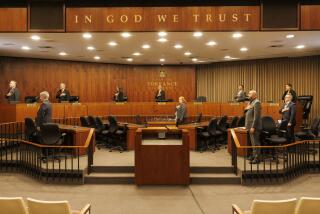Fee for Building Homes Goes Up 136% in Torrance
- Share via
With little debate, the Torrance City Council has approved a 136% increase in taxes and fees on all new residential units to pay for parks and recreation.
The council voted 5 to 1 to establish a new $750 fee for park rehabilitation and open space preservation, on top of an existing $550 park and recreation facilities tax, for a total of $1,300.
Objection to Fee
Councilman Bill Applegate objected to the new fee, saying it was a back-door method of raising taxes. “The reason for calling it a fee is so we don’t have to go to the people,” he said.
Under Proposition 13, cities are required to obtain voter approval for any increase in special taxes dedicated to a specific purpose. Consequently, the existing park and recreation tax could not be increased without a vote.
But a new state law allows cities to establish new fees if a direct relationship can be shown between the fee and public improvements.
“We’re using a loophole in the law to increase taxes,” Applegate said.
However, after the votes were counted and the fee had been approved, Applegate joined his colleagues in voting for a separate implementing ordinance. “I lost my battle so I just voted for it,” Applegate said. “It was a done deal.”
If a builder refuses to pay the park fee, the ordinance provides for a new $750 general tax on new residential units. Both the fee and the tax will be adjusted annually based on inflation.
The money must be paid before a building permit is issued.
The tax is permitted under state law because it would be used for general operations rather than a specific purpose. City officials were concerned that the fee might be subject to a legal challenge and enacted the tax as a backup.
The tax or fee applies to each new single-family home, apartment, duplex, condominium, motel unit and any rebuilding project that increases the total floor area of a dwelling by more than 85%.
Mayor Katy Geissert said the alternative to imposing the fee is “doing nothing and letting our parks deteriorate.”
Geissert said population increases will create a need for more parks in Torrance.
A detailed report, outlining the basis for the fee, notes that historically Torrance has provided 2.5 acres of developed park and recreation facilities for every 1,000 residents.
Based on projections of 5,100 new residents by 2010, the report said Torrance would need to develop 12.75 acres of undeveloped park land and open space and to restore and renovate existing parks and facilities that are suffering from deterioration or overuse.
Proceeds from the new $750 fee would be devoted to acquisition and rehabilitation purposes, such as replacement of worn-out equipment. Funds raised from the $550 tax are devoted exclusively to capital projects such as acquisition of parkland and construction of buildings.
Parks Expenditures Curtailed
But Torrance’s capital expenditures for parks have been curtailed because the city borrowed the entire balance of $1.75 million in park funds to help repair a major landslide on the north face of the Palos Verdes Peninsula. So far $200,000 of the loan has been repaid.
“We would be in a much stronger position relative to our capital needs if the funds had not been loaned out,” said Torrance Parks and Recreation Director Gene Barnett. “We are anticipating that will be paid back. We don’t know when that will happen.”
He said improvements to Madrona Marsh and the former Greenwood school site have been delayed because the money is no longer available.
Barnett said the fee was proposed because the $550 tax, last raised in 1975, is not keeping pace with inflation.
Based on the rise in the Consumer Price Index since 1975, Torrance Revenue Officer Ben Murdoch said, the tax should be about $1,300 today.
More to Read
Sign up for Essential California
The most important California stories and recommendations in your inbox every morning.
You may occasionally receive promotional content from the Los Angeles Times.










